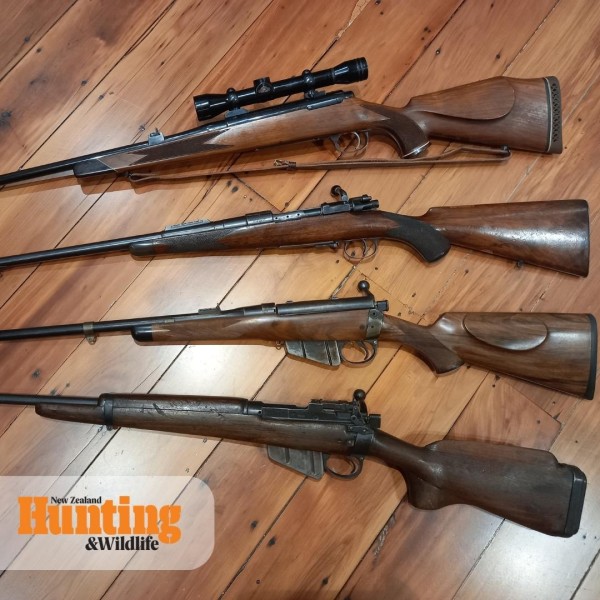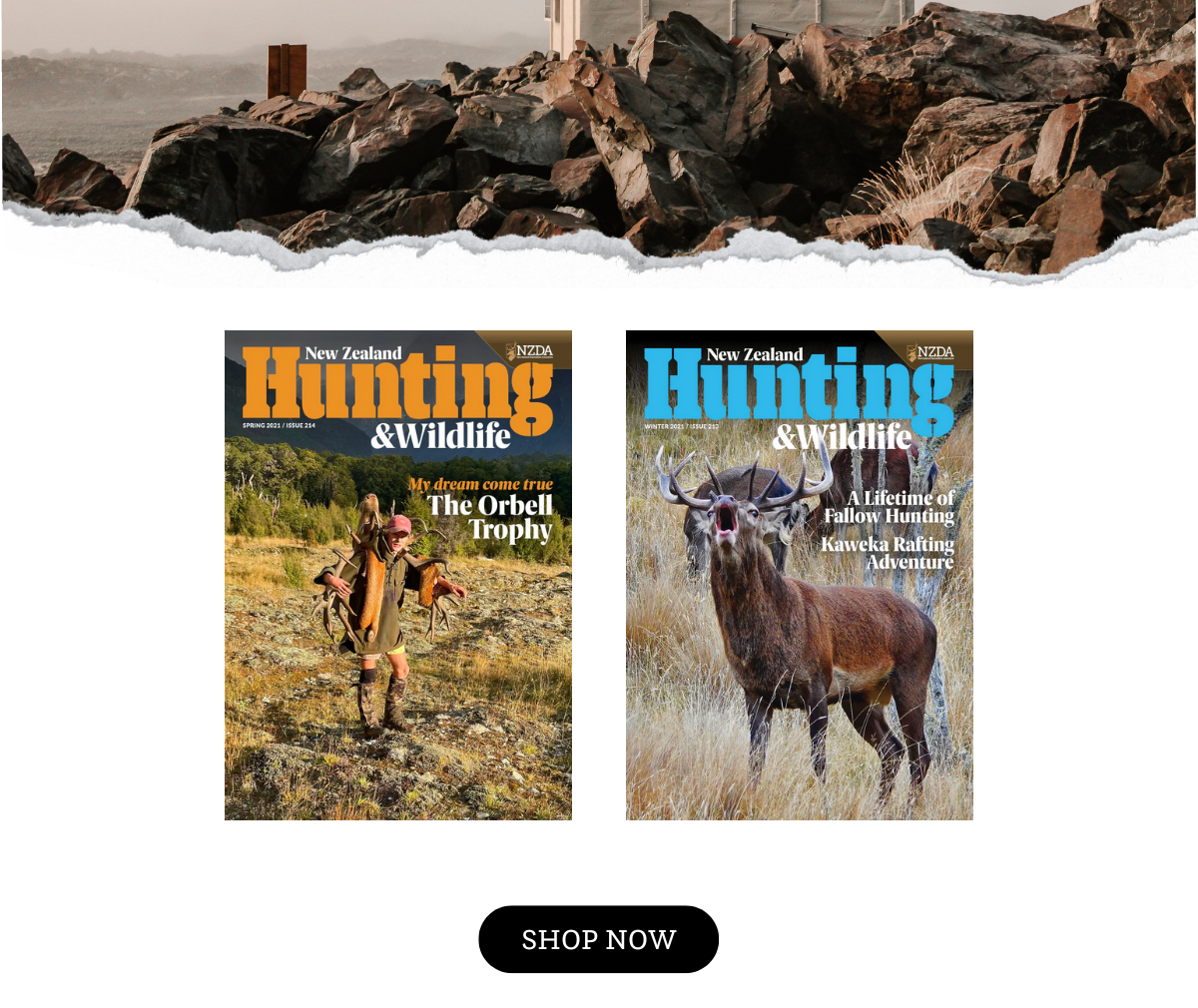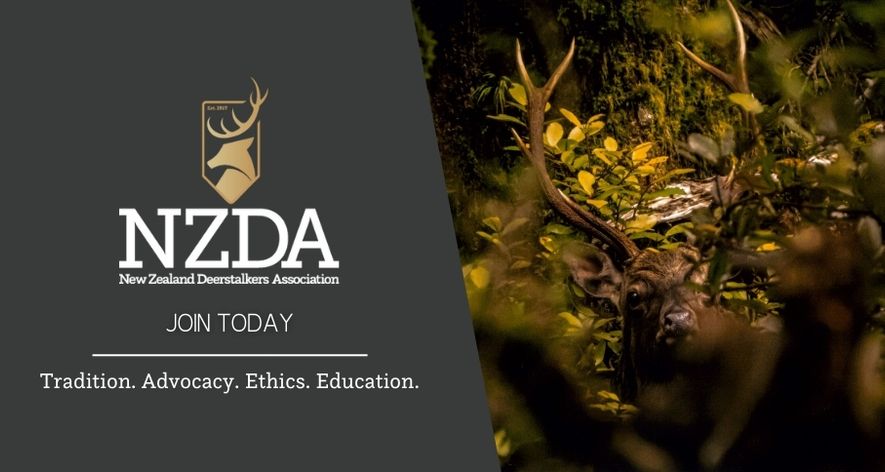27 August 2023
Hunting and Wildlife Magazine - Autumn Issue 220
Words By: Chaz Forsyth

Top to bottom: Hong Tse M65 Shultz n Larsen 7x61, Hong Tse Westley Richards M98 in .318 Accelerated Express, Ian Wright .303 SMLE Longtom, Geoffrey Orbell .303 Jungle Carbine.
Introduction
Having attended a few annual conferences, it is notable that at times, the ‘top table’ seems isolated from the branch representatives on the floor. That is because they’re ‘carrying the bag’ of responsibility for the association. In fact of course they’re all members of the New Zealand Deerstalkers’ Association (NZDA), and have shown willing to ‘put their hands up’ by taking on additional responsibilities for the improvement of the interests of NZDA members.
Incidentally, they’re all hunters although their present responsibilities may have sharply reduced their hunting opportunities. I did some research to find out about the rifles used by our national presidents and it is an interesting mix of brands and calibres. The national presidents of the 1950s and 1960s may have passed on, but there are details held about the rifles they used. The rifle detail mentioned is not exhaustive and this incompleteness results from the passage of time, incomplete records and the likelihood of later acquisitions making my compilation out of date.
The first few presidencies
Our first national president is known to have used a .303 No 5 rifle (‘jungle carbine’) for his hunting after the Second World War. These carbines only came into existence in late 1944, so what Dr Orbell used for his earlier hunting is not known but is likely to have been an earlier version of the .303 rifle. The second president was Newton McConochie, who in his book recounted using a muzzle loaded shotgun before ‘graduating’ to a “Schneider” carbine, clearly a .577 Snider breech loader. He then used for a short time, a .303 which had been fraudulently sold to him before it was repossessed by its rightful owner. All of McConochie’s firearms predated the instigation of the New Zealand Deerstalkers’ Association by some decades.
The third national president, Harvie Morrow, is known to have used a .425 Westley Richards, perhaps for some New Zealand hunting, certainly for his successful tiger hunt in India, but his grandson has also mentioned a Schultz and Larsen model 54J rifle chambered in .270 Winchester. The rifles used by W. H. (Halsey) Robinson and Jack Dillon have not yet been discovered, but when I first contacted Jack in the late 1960s he had an assortment of metric calibre rifles in his shop, some in medium bores (larger than .30”, 7.62 mm calibre) for sale and the possibility exists that he used some of these for his hunting. It was a 9.3 x 63 mm which caught my eye, and I remember him telling me it was a ‘bull-walloper’ in a letter he sent me ‘way back in the mid-1960s.
This covers the first few National presidents, up until the mid-1960s, a period during when attempts had been made by external agencies to ‘stamp NZDA out’ and to resolve the deer problem ‘once and for all’. The use of poisons had been experimented with and NZDA had matured following its successful petition which in 1958, attracted 80,001 signatures, only to be eclipsed by the ‘Save Lake Manapouri’ petition a decade later with its 250,000 signatures.
The mid-1960s – tumult as NZDA interest broadened
John Anderson used a Brno in 7 x 57 mm, possibly a Model 21, before moving to one of Colin Murdoch’s Paxarm syringe tranquilising rifles in the late 1960s when he pioneered the live capture of deer and a wapiti female (subsequently sterilised on specific instruction from the NZ Forest Service!)
John B Henderson (‘JBH’), national president 1968 – 1972, started his hunting (as most of us did) with a .303, most likely a Short Magazine Lee Enfield (SMLE), before moving to a Brno Model 21 in 7 x 57. His successor was Ian D Wright, an expatriate Australian who luckily (for us) adopted New Zealand as his homeland. Ian, a co-founder of the New Zealand Shooting Federation and one of the founders of the New Zealand Cartridge Collectors Club, used an Oberndorf 7 x 57 Mauser, but also used an Oberndorf .270 Winchester and another Mauser in 9.5 x 57 mm.
Alan Evans, who succeeded Ian Wright in 1974, used a BSA “Viscount” model chambered n .270W for his hunting. The elegance of these rifles endeared themselves to a generation of hunters who eschewed the surplus service .303s with which many of us began our hunting. The range of chambering’s in which they were offered generally outperformed (on paper at least) the .303 British cartridge.
Watershed year – Wild Animal Control Act 1977
Hong Tse, a keen hunter (who could recall paying the poll tax applied to those of Chinese origin) was a keen hunter as well as one of the co-founders of the New Zealand Shooting Federation. He used to hunt with a .358 Norma magnum, chambered in a Schultz and Larsen, mentioning trips with Ian Wright to the South Island West Coast. (He was with Ian Wright when Ian, climbing along the outside of one of the steel girder bridges across one of the West Coast rivers, possibly the Karangarua, lost a rifle from his shoulder when its sling broke).
Successor to Hong Tse was Howard Egan, who mentioned two rifles to me. The first was his .270 Winchester, make unknown but possibly BSA. The second was a BSA “Stutzen”, one of the last BSAs produced before the factory was sold to overseas interests, in 6.5 x 57 mm (one of many chambering’s in which these rifles were offered).
More tumult – addressing the ‘wapiti issue’ and other impacts
John Henderson was elected to the national presidency again in the early 1980s and no doubt his choice of rifles was still the same. Another John, John Bamford, succeeded JBH. John started his hunting with a .303 Martini-Henry before ‘graduating’ to a Husqvarna Crown .30-06. John Bamford served six terms as national president, his time spanning the complete re-organisation of central government departments and coincided with the ‘wapiti saga’, a sequence of events which eventually led to the formation of the NZ Wapiti Foundation.
David Hodder, national president for three years, used a variety of rifles and chambering’s, recalling a P14 (.303 Br), an SMLE (also in .303 Br), a BSA “Majestic” in .308W, a Ruger M77 in 7mm-08, and a lighter weight Remington Model 7 in .243W. Ian Wright’s election to the position of national president took place in 1992 and his choice of rifles was unchanged. Alby Frampton, upon his election to the position of national president in 1995, recalled using a P14 .303 when he started hunting before moving on to a Model 70 Winchester XTR in .308W. He found that cartridge and rifle combination worked well for him.
The dawning of the millennium
Doug Davies, a senior cricketing umpire, described starting with an SMLE, in .303 British of course, before switching to a BSA model CF2 in 7 x 57 mm. This model of BSA was one of the last designs of the BSA works, and unlike the Viscount and Majestic models, was offered in only one action length, so making rifles chambered for .222 Remington somewhat clumsy, but in larger cartridges would be more widely accepted.
The late Trevor Dyke used a wide variety of rifles for his hunting, including a .58 calibre muzzle loader built by Tony Hawkins, a New Zealander who pioneered barrel making here. Trevor also mentioned a BSA model CF2 in .270W, a Brno Fox in .222 Remington, and a.222 or .223 Savage, possibly a Model 340. Steven Veail, who succeeded Trevor, also used a wide range of rifles, starting with a Mauser Model VZ 33 in 8 x 57 mm, a series of .308W rifles, including a Winchester Model 70, a Brno and a Harrington and Richardson single shot. Steven also mentioned a Harrington and Richardson single shot .243W and a Baikal single shot in .223 Remington.
Alec McIver, elected after Steven Veail in 2007, mentioned a SAKO .308W, a .300WSM and a Ruger M77 in .308W. His successor, Tim McCarthy, started out with an SMLE in the ubiquitous .303 British, with a Remington M600 Mohawk in .243W, a CZ in .223 Remington, a Zastava ‘Mini Mauser’ in .338 Whisper and a walnut stocked Remington Mohawk in .308W. (The walnut stock of the last-mentioned rifle is of interest because I had previously seen only beech used for stocking these rifles.)
A new era – hunting ‘valued introduced species’
The election of Bill O’Leary coincided with the advent of the Game Animal Council, a statutory body which legitimised hunters by changing their status from ‘pest hunters’ to hunters of valued introduced species’. Bill mentioned starting his hunting with an SMLE (you’ll know its chambering by now), switching to a BSA Hunter in .308W, then another BSA Hunter (.222 Remington), an ex - police Brno Model 601 in .223 Remington, followed by a Thompson Center Icon in .22-250 Remington. Bill’s successor, Trevor Chappell, started his hunting with a .270 Winchester (rifle make and model unknown) before going to the .22-250 Remington cartridge, the make and model of which rifle also remains unknown.
The current national president, Craig Benbow also started his hunting experiences with an SMLE before moving to a Midland .30-06. He then switched to a Howa chambered in .260 Remington, replacing this with another of the same make, model and calibre after a mechanical failure.
Commentary
The active interest shown by national presidents in hunting surely reflects the egalitarian nature and accessibility of recreational hunting in New Zealand for New Zealanders. Their choice of rifles and to a slightly lesser extent, of calibres, is highly egalitarian too, in that their first hunting rifles are largely rifles from previous ‘government service’ before being released for sale to the public for legitimate pursuits like hunting. Hunting rifles used later by national presidents are almost entirely commercially manufactured brands in popular calibres
This highlights the extent to which the cultural heritage of hunting continues to permeate New Zealand society, and the extent to which those elected to the highest positions within the major organisation representing New Zealand wild animal hunting continue to keep their ‘feet on the ground’ while working, as volunteers, to enhance the best interests of the members of the New Zealand Deerstalkers’ Association. That these activities (and people) also generally benefit the welter of non-members of NZDA, cannot be overlooked either.
References
Anderson, J. A. (1987), The Eye of the Hunter. McConochie, N. (1966), You’ll Learn No Harm from the Hills.
Personal communications
John Bamford, Craig Benbow, Trevor Chappell, Trevor Dyke, Howard Egan, Alby Frampton, David Hodder, Tim McCarthy, Alec McIver, Harvie Morrow, Hamish Norton, Bill O’Leary




